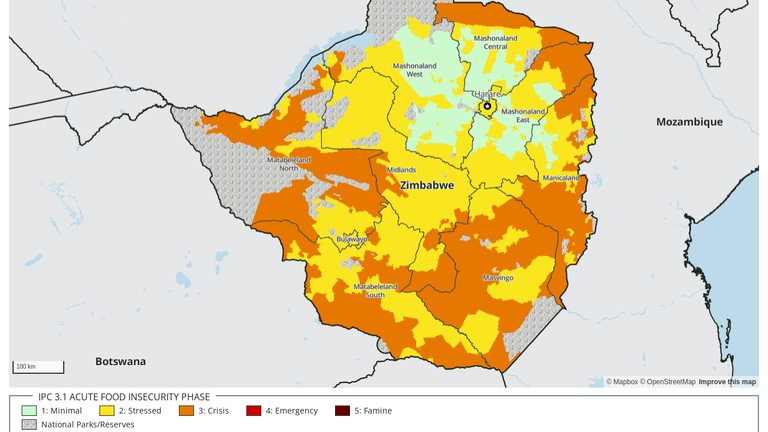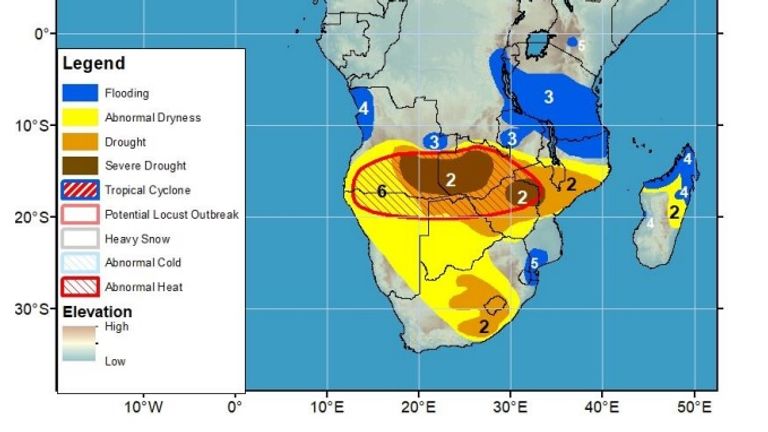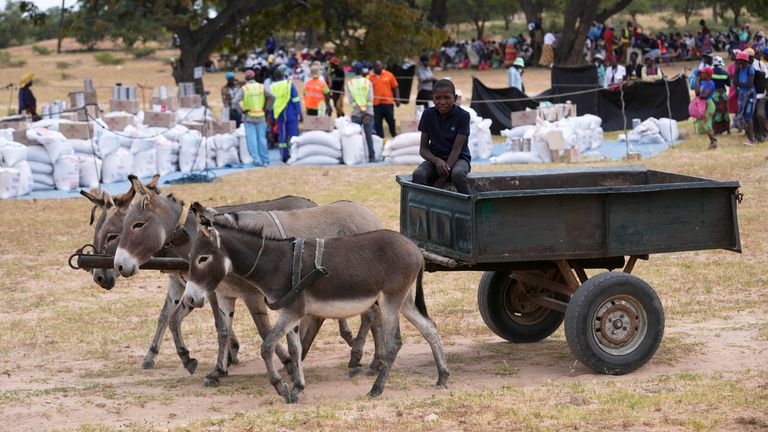President Emmerson Mnangagwa also called for two billion dollars (£1.6bn) in humanitarian aid.
James Robinson
News reporter @thejournojames
Wednesday 3 April 2024

A farmer in Mangwe district in southwestern Zimbabwe,
stands in the middle of his dried-up crop field.
Zimbabwe has joined Zambia and Malawi in declaring a state of disaster over a devastating drought sweeping across much of southern Africa.
President Emmerson Mnangagwa made the emergency declaration in a speech on Wednesday and called for two billion dollars (£1.6bn) in humanitarian aid.
He said more than 80% of the country had received "below-normal rainfall" due to an "El Nino-induced drought".
El Nino is a naturally occurring climatic phenomenon that warms parts of the Pacific Ocean every two to seven years.
While it has varied effects on the world's weather, in southern Africa it typically causes below-average rainfall.
However, this year has seen the worst drought in decades, with El Nino amplifying the impacts of human-induced climate change, according to experts.
A delayed start to the rainy season, followed by general low rainfall, has devastated harvests in large parts of southern Africa, and, according to humanitarian groups, left millions of people in need of food assistance.

Zimbabwe has joined Zambia and Malawi in declaring a state of disaster over a devastating drought sweeping across much of southern Africa.
President Emmerson Mnangagwa made the emergency declaration in a speech on Wednesday and called for two billion dollars (£1.6bn) in humanitarian aid.
He said more than 80% of the country had received "below-normal rainfall" due to an "El Nino-induced drought".
El Nino is a naturally occurring climatic phenomenon that warms parts of the Pacific Ocean every two to seven years.
While it has varied effects on the world's weather, in southern Africa it typically causes below-average rainfall.
However, this year has seen the worst drought in decades, with El Nino amplifying the impacts of human-induced climate change, according to experts.
A delayed start to the rainy season, followed by general low rainfall, has devastated harvests in large parts of southern Africa, and, according to humanitarian groups, left millions of people in need of food assistance.

Much of Zimbabwe is on track for 'crisis' levels of food insecurity.
Pic: FEWS.NET


A huge swathe of southern Africa is suffering from abnormally dry conditions.
Pic: NOAA/USAID/ EWS-NET
An estimated nine million people have been impacted by the drought in Malawi, along with more than six million in Zambia, UNICEF said.
Both countries declared a state of emergency last month.
Advertisement
Mr Mnangagwa said the top priority of the government of Zimbabwe - a country home to more than 15 million people - was to "secure food for all Zimbabweans".
"No Zimbabwean must succumb to, or die from, hunger," he said.

An estimated nine million people have been impacted by the drought in Malawi, along with more than six million in Zambia, UNICEF said.
Both countries declared a state of emergency last month.
Advertisement
Mr Mnangagwa said the top priority of the government of Zimbabwe - a country home to more than 15 million people - was to "secure food for all Zimbabweans".
"No Zimbabwean must succumb to, or die from, hunger," he said.

Zimbabwe's President Emmerson Mnangagwa. Pic: Reuters
He appealed to United Nations agencies, local businesses and faith organisations to contribute towards humanitarian assistance.
Approximately 2.7 million people are at risk of hunger in Zimbabwe, according to aid groups.
He appealed to United Nations agencies, local businesses and faith organisations to contribute towards humanitarian assistance.
Approximately 2.7 million people are at risk of hunger in Zimbabwe, according to aid groups.
In Zimbabwe, the United Nations' World Food Programme has already rolled out a food assistance programme targeting those at risk from January to March.
More than 60% of the population in Zimbabwe live in rural areas, growing the food they eat, and sometimes small surpluses that can be sold to cover expenses such as school fees.

A young boy with a donkey cart arrives to receive food aid in Mangwe district in southwestern Zimbabwe.


People carry a bag of sorghum - a cereal also known as broomcorn - during a food distribution in Mangwe district in southwestern Zimbabwe.
Mr Mnangagwa's declaration will open the way for aid agencies to mobilise international support for more aid, but many people may still fail to get assistance, which is likely to be targeted to the most vulnerable populations.
The United States Agency for International Development (USAID) - the US government's foreign aid agency - has estimated through its Famine Early Warning Systems Network that 20 million people in southern Africa needed food relief between January and March.
These needs could extend into early 2025 for many people in areas of highest concern such as Zimbabwe, southern Malawi, parts of Mozambique and southern Madagascar because of El Nino, USAID said.
Mr Mnangagwa's declaration will open the way for aid agencies to mobilise international support for more aid, but many people may still fail to get assistance, which is likely to be targeted to the most vulnerable populations.
The United States Agency for International Development (USAID) - the US government's foreign aid agency - has estimated through its Famine Early Warning Systems Network that 20 million people in southern Africa needed food relief between January and March.
These needs could extend into early 2025 for many people in areas of highest concern such as Zimbabwe, southern Malawi, parts of Mozambique and southern Madagascar because of El Nino, USAID said.
No comments:
Post a Comment